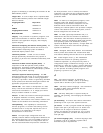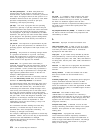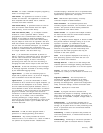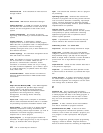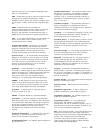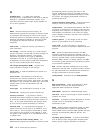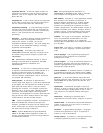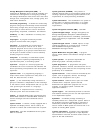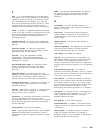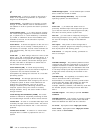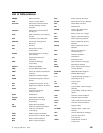T
task. (1) In a multiprogramming or multiprocessing
environment, one or more sequences of instructions
treated by a control program as an element of work
to be accomplished by a computer. (2) In VSE, the
basic unit of synchronous program execution. A task
competes with other tasks for computer system
resources such as processing time and I/O channels.
Telnet. In TCP/IP, an application protocol that allows
a user at one site to access a remote system as if the
user′s display station were locally attached. Telnet
uses the Transmission Control Protocol as the
underlying protocol.
temporary data set. A data set that is created and
deleted in the same job. Contrast with nontemporary
data set.
temporary storage. In computer programming,
storage locations reserved for intermediate results.
Synonymous with working storage.
test plan. A plan that establishes detailed
requirements, criteria, general methodology,
responsibilities, and general planning for test and
evaluation of a system.
Time Sharing Option (TSO). An operating system
option; for the System/370 system, the option
provides interactive time sharing from remote
terminals.
token-ring network. A network that uses a ring
topology, in which tokens are passed in a circuit from
node to node. A node that is ready to send can
capture the token and insert data for transmission.
transaction processing. A sequence of operations on
a database that is viewed by the user as a single,
individual operation.
transient. Pertaining to a program or subroutine that
does not reside in main storage or to a temporary
storage area for such a program.
transparent. (1) Pertaining to operations or data that
are of no significance to the user. (2) In data
transmission, pertaining to information not recognized
by the receiving program or device as transmission
control characters.
transportability. Synonym for portability.
TSCF. Target System Control Facility. Part of System
Automation OS/390 which uses NetView to allow a
host OS/390 system to automate operations at target
systems.
TSO/E. time sharing option/extended. An option on
the operating system; for System/370, the option
provides interactive time sharing from remote
terminals.
U
unit address. The three-character address of a
device, specified at the time a system is installed; for
example, 191 or 293.
unit of work. In advanced program-to-program
communications, the amount of processing that is
started directly or indirectly by a program on the
source system.
update authority. The ability to add, change, or
cancel items.
upward compatibility. The capability of a computer to
execute programs written for another computer
without major alteration, but not vice versa.
user catalog. See VSAM user catalog.
user exit. A programming service provided by an
IBM software product that may be requested during
the execution of an application program for the
service of transferring control back to the application
program upon the later occurrence of a user-specified
event.
user identification (user ID). (1) A string of
characters that uniquely identifies a user to a system.
(2) The name used to associate the user profile with a
user when a user signs on the system.
user interface. (1) Hardware, software, or both that
allows a user to interact with and perform operations
on a system, program, or device. (2) In SAA usage,
any of the actions or items defined by Common User
Access (CUA) architecture that allow a user to
interact with and perform operations on a computer.
user profile. In computer security, a description of a
user that includes such information as user ID, user
name, password, access authority, and other
attributes obtained at logon.
user program. A user-written program.
user-defined word. In COBOL, a word that must be
supplied by the user to satisfy the format of a clause
or statement.
utility program. A computer program in general
support of computer processes; for example, a
diagnostic program, a trace program, a sort program.
Synonymous with service program.
Glossary 581



